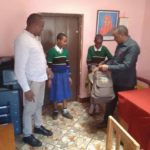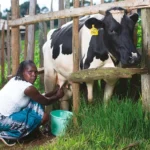Introduction
Semi-arid regions are known for their harsh climates, with long dry spells, limited rainfall, and temperatures that can swing dramatically between day and night. In places like Longido, Arusha, Tanzania, these conditions create a unique set of challenges for both the environment and the communities living there. On World Environment Day, Engikarate Primary School embraced a transformative activity—planting fruit trees to not only improve their surroundings but also empower their community, especially the local Maasai population, to adopt sustainable environmental practices.
Understanding Semi-Arid Areas
Definition and Climate Characteristics
Semi-arid areas receive between 250mm and 500mm of rainfall annually. The climate is dry, and prolonged droughts are common. Vegetation is sparse, and the soil often struggles to retain water, making agriculture particularly challenging.
Challenges Faced by Communities
Residents must navigate food insecurity, limited water availability, and soil degradation. These challenges often push communities to rely on traditional livestock grazing, which, if unmanaged, can further deplete natural resources.
Role of Vegetation in Ecosystem Balance
Trees and shrubs play a crucial role in maintaining soil integrity, regulating local temperatures, and supporting biodiversity. Planting fruit trees introduces both environmental stability and practical benefits for communities.
The Maasai Community and Their Environment
Overview of Maasai Culture
The Maasai people are semi-nomadic pastoralists known for their deep connection to cattle and traditional ways of life. Their cultural practices have been shaped by the semi-arid landscapes of northern Tanzania.
Interaction with Natural Resources
The Maasai rely heavily on grazing lands, but limited vegetation and unpredictable rainfall can threaten their livestock and livelihoods.
Traditional Land Use and Its Limitations
Overgrazing and the absence of diversified crops leave the land vulnerable to erosion and reduced fertility. Integrating tree planting offers a complementary approach to sustaining their environment.
Why Fruit Tree Planting Matters
Soil Conservation and Erosion Control
Fruit trees anchor the soil with their root systems, preventing erosion caused by wind and water.
Climate Adaptation and Microclimate Improvement
Trees create shade, reduce local temperatures, and increase soil moisture retention, helping communities adapt to climate extremes.
Food Security and Nutrition
By producing fruits, these trees provide essential nutrients, diversify diets, and reduce dependence on purchased food.
Benefits for School Environments
Educational Opportunities for Children
Students gain hands-on experience in agriculture and environmental science, fostering lifelong skills and awareness.
Creating Green and Shaded Spaces
Tree planting transforms school grounds into healthier, shaded areas conducive to outdoor learning and recreation.
Encouraging Environmental Stewardship
Involving children in planting nurtures a sense of responsibility toward nature and promotes future advocacy for sustainability.
Economic and Livelihood Impacts
Fruit as a Source of Income
Surplus fruits can be sold locally, generating additional household income for families, including Maasai households.
Sustainable Agricultural Practices
Growing fruit trees encourages diversification, reduces dependency on livestock, and promotes long-term land stewardship.
Community Empowerment
Tree planting initiatives bring communities together, enabling knowledge sharing and collective action for environmental management.
Biodiversity and Wildlife Support
Fruit Trees as Habitats for Birds and Insects
Flowering and fruiting trees attract pollinators and birds, enriching local biodiversity.
Strengthening Local Ecosystems
By providing food and shelter for wildlife, fruit trees contribute to a balanced and resilient ecosystem.
Water Management in Semi-Arid Regions
Tree Roots and Groundwater Replenishment
Deep roots help water infiltrate into the soil, enhancing groundwater availability.
Reducing Water Evaporation from Soil
Shade from trees lowers soil temperatures and slows water evaporation, conserving precious moisture for crops and grazing land.
Steps Taken at Engikarate Primary School
Planning and Preparation
Teachers and students mapped out suitable planting sites, selecting areas with adequate sunlight and minimal interference from livestock.
Student and Teacher Participation
Children actively dug holes, applied compost, and planted young saplings under teacher guidance, creating a sense of ownership.
Planting Techniques Used
Mulching, spacing, and protective measures were applied to ensure saplings survive harsh conditions and thrive.
Challenges in Fruit Tree Planting
Water Scarcity
Limited rainfall can stress young trees, requiring supplemental irrigation methods like water harvesting or drip systems.
Soil Quality Issues
Nutrient-poor soils demand enrichment through composting and organic fertilizers to support growth.
Community Awareness and Involvement
Sustaining tree planting efforts requires continuous community education and participation.
Strategies for Success
Choosing Drought-Resistant Species
Species like mango, pawpaw, and guava are suitable for semi-arid regions, capable of withstanding dry spells.
Mulching and Irrigation Techniques
Covering soil with organic mulch preserves moisture, while simple irrigation systems ensure consistent hydration.
Continuous Care and Monitoring
Regular pruning, pest control, and watering safeguard tree health and productivity.
Role of Environmental Education
Integrating Tree Planting into Curriculum
Linking planting activities to science, geography, and social studies deepens learning.
Hands-On Learning Benefits
Experiential learning strengthens retention, sparks curiosity, and encourages problem-solving skills.
Raising Future Environmental Leaders
Children learn early the importance of conservation, nurturing responsible citizens committed to sustainability.
Community Engagement and Collaboration
Involving Local Elders and Maasai Leaders
Engaging respected community figures ensures cultural acceptance and long-term support.
Encouraging Household Tree Planting
Families replicate school initiatives at home, expanding environmental impact beyond the school grounds.
Partnerships with NGOs and Government Bodies
Collaborations provide technical support, seedlings, and knowledge transfer for broader community benefits.
Long-Term Impact on Longido
Potential for Food Security Improvement
Access to fresh fruits enhances diets and reduces vulnerability during drought periods.
Environmental Restoration
Planting trees mitigates land degradation, improves soil quality, and supports biodiversity.
Cultural Integration and Pride
Linking tree planting with Maasai traditions fosters pride in the land while promoting sustainable practices.
Conclusion
Fruit tree planting in semi-arid areas like Longido, Arusha, represents more than a simple environmental act—it’s a step toward sustainable livelihoods, better nutrition, and resilient ecosystems. Initiatives like those at Engikarate Primary School show that when communities, schools, and cultural traditions unite, positive change is not just possible—it’s thriving. By planting trees, we plant hope for generations to come.
FAQs
1. Why are fruit trees important in semi-arid areas?
They prevent soil erosion, improve microclimates, provide food, and support biodiversity.
2. How can schools contribute to environmental conservation?
Schools can integrate tree planting into curricula, engage students in hands-on activities, and educate communities about sustainability.
3. What fruit trees grow best in Longido, Arusha?
Mango, pawpaw, guava, and tamarind are suitable due to their drought tolerance.
4. How does tree planting benefit the Maasai community?
It diversifies food sources, generates income, and enhances environmental resilience.
5. What steps ensure the survival of young trees in dry regions?
Selecting drought-resistant species, mulching, supplemental watering, and regular care are essential.









